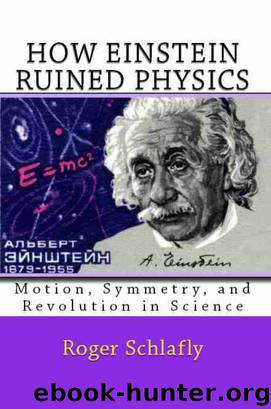How Einstein Ruined Physics by Roger Schlafly

Author:Roger Schlafly
Language: eng
Format: epub
Tags: revolution, relativity, einstein, paradigm, symmetry
Publisher: Roger Schlafly
Credit for relativity
The theory of relativity can be divided into the general theory and the special theory, and the special theory can be divided into what could be called the easy part and the hard part. The general theory is harder than even the hard of special relativity, and is discussed in the next chapter. It is the special theory that is considered to have revolutionized 20th century physics, and which is studied so carefully by historians, philosophers, and others.
The easy part of special relativity consists largely of accepting the logical consequences of the Michelson-Morley experiment. Michelson created a sensation when he showed in 1881 that the speed of light appeared to be the same in all directions. Doubts about his experiment caused him to do it much more precisely with his colleague Morley in 1887, with the same results. The prevailing ideas about the symmetries of the universe had to be fundamentally wrong. Either the experiment was wrong, or the Earth was stationary in the aether, or everyone had some misunderstanding about light or measurement.
Fitzgerald proposed a length contraction in 1889 as a consequence of the speed of light being the same for all observers, and so did Lorentz in 1892. By 1900, Lorentz, Larmor, and Poincare had given the corresponding time transformations. Voigt had them also, in a limited context. This was the easy part of the theory. Light was known to be electromagnetic, and Lorentz had proved a theorem in 1895 on how these transformations are compatible with Maxwell’s equations for electricity and magnetism.
Maxwell’s earlier contributions are also overlooked. He created the first fully relativistic theory. He coined the term “relativity” and wrote about the impossibility of determining absolute velocity. His equations implied a constant speed of light. He suggested an experiment like Michelson’s so that it would either detect the Earth’s motion or confirm the relativity principle. He was missing the Lorentz transformations, but that would have been the next step.
Einstein’s famous 1905 paper is half kinematic and half electromagnetic, and it was an exposition of this easy part of the theory. His kinematic part explains how the Lorentz transformations can be deduced from the speed of light appearing the same to all observers, without mentioning Michelson-Morley, FitzGerald, Lorentz, Poincare, or the others who did related work. His electromagnetic part is an account of Lorentz’s 1895 theorem. The paper partially treated the higher-order velocity effects, which was an advantage over the earlier papers of Lorentz and Poincare, but not over their later papers. It was considered an embellishment of Lorentz’s theory by physicists at the time. In 1906, Lorentz described Einstein’s work as adding an interpretation of local time by means of clock synchronization. Einstein only started trying to distinguish his theory from Lorentz’s in 1907, when his main claim was that his approach was less ad hoc because he interpreted Lorentz’s “local time” (ortszeit) as time. Minkowski similarly argued in 1908 that Einstein’s contribution was to identify Lorentz’s local time with the time of an electron.
Download
This site does not store any files on its server. We only index and link to content provided by other sites. Please contact the content providers to delete copyright contents if any and email us, we'll remove relevant links or contents immediately.
The Complete Stick Figure Physics Tutorials by Allen Sarah(7135)
Secrets of Antigravity Propulsion: Tesla, UFOs, and Classified Aerospace Technology by Ph.D. Paul A. Laviolette(4974)
Thing Explainer by Randall Munroe(3782)
The River of Consciousness by Oliver Sacks(3412)
The Order of Time by Carlo Rovelli(3072)
How To by Randall Munroe(2911)
I Live in the Future & Here's How It Works by Nick Bilton(2839)
A Brief History of Time by Stephen Hawking(2819)
What If?: Serious Scientific Answers to Absurd Hypothetical Questions by Randall Munroe(2542)
The Great Unknown by Marcus du Sautoy(2532)
Midnight in Chernobyl by Adam Higginbotham(2385)
Blockchain: Ultimate Step By Step Guide To Understanding Blockchain Technology, Bitcoin Creation, and the future of Money (Novice to Expert) by Keizer Söze(2379)
Networks: An Introduction by Newman Mark(2264)
The Meaning of it All by Richard Feynman(2213)
Easy Electronics by Charles Platt(2204)
The Tao of Physics by Fritjof Capra(2162)
Midnight in Chernobyl: The Untold Story of the World's Greatest Nuclear Disaster by Adam Higginbotham(2074)
When by Daniel H Pink(2020)
Introducing Relativity by Bruce Bassett(2017)
